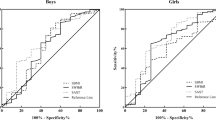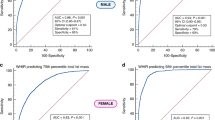Abstract
Objective:
To determine the comparability of triceps and subscapular skinfold thicknesses with dual X-ray absorptiometry (DXA) whole-body total fat (kg) in relation to serum triglyceride (TG) levels and increased risk of elevated TG levels, and identified optimum skinfold cutoffs for screening purposes in US adolescents.
Subjects/Methods:
Data from triceps and subscapular skinfold thickness, DXA whole-body total fat and serum TGs were obtained from 1505 US adolescents ages 12.00–17.99 years, who participated in two continuous National Health and Nutrition Examination Survey (NHANES) cycles 2001–2004. Study associations were examined with linear and logistic models, and ROC (receiver operating characteristic) analyses were used to derive skinfold cutoffs for identifying the risk of elevated TG levels.
Results:
Using area under the curves (AUCs) as metrics of prediction accuracy (with bootstrapped 95% CIs), no significant differences were found between skinfolds and DXA logistic models for predicting elevated TG levels. Similarly, skinfold and DXA models had comparable precision in predicting continuous serum TG from bootstrapped root mean squared errors for both sexes. Population-adjusted marginal mean estimates indicated that youths whose skinfolds are in the top quartile had TG levels within 83–108 mg/dl. Skinfold cutoffs for predicting elevated estimated TG using ROC analyses showed that cutoffs decreased with age and ranged from 13 to 30 mm for ages 12–17, in yearly intervals.
Conclusion:
Skinfold thicknesses were comparable to DXA whole-body total fat in predicting serum TG levels. These skinfold cutoffs could be used in practical settings as a first pass screener for identifying US adolescents at risk of elevated serum TGs.
This is a preview of subscription content, access via your institution
Access options
Subscribe to this journal
Receive 12 print issues and online access
$259.00 per year
only $21.58 per issue
Buy this article
- Purchase on Springer Link
- Instant access to full article PDF
Prices may be subject to local taxes which are calculated during checkout
Similar content being viewed by others
References
Goran MI, Malina RM . Fat distribution during childhood and adolescence: implications for later health outcomes. Am J Hum Biol 1999; 11, 187–188.
Freedman DS, Dietz WH, Srinivasan SR, Berenson GS . The relation of overweight to cardiovascular risk factors among children and adolescents: the Bogalusa Heart Study. Pediatrics 1999; 103 (6 Pt 1), 1175–1182.
Srinivasan SR, Myers L, Berenson GS . Predictability of childhood adiposity and insulin for developing insulin resistance syndrome (syndrome X) in young adulthood: the Bogalusa Heart Study. Diabetes 2002; 51, 204–209.
Steinberger J, Daniels SR, Eckel RH, Hayman L, Lustig RH, McCrindle B et al. Progress and challenges in metabolic syndrome in children and adolescents: a scientific statement from the American Heart Association Atherosclerosis, Hypertension, and Obesity in the Young Committee of the Council on Cardiovascular Disease in the Young; Council on Cardiovascular Nursing; and Council on Nutrition, Physical Activity, and Metabolism. Circulation 2009; 119, 628–647.
Cali AM, Caprio S . Obesity in children and adolescents. J Clin Endocrinol Metab 2008; 93 (11 Suppl 1), S31–S36.
Ogden CL, Carroll MD, Curtin LR, McDowell MA, Tabak CJ, Flegal KM . Prevalence of overweight and obesity in the United States, 1999–2004. JAMA 2006; 295, 1549–1555.
Broyles S, Katzmarzyk PT, Srinivasan SR, Chen W, Bouchard C, Freedman DS et al. The pediatric obesity epidemic continues unabated in Bogalusa, Louisiana. Pediatrics 2010; 125, 900–905.
Daniels SR, Greer FR . Lipid screening and cardiovascular health in childhood. Pediatrics 2008; 122, 198–208.
Freedman DS, Wang J, Ogden CL, Thornton JC, Mei Z, Pierson RN et al. The prediction of body fatness by BMI and skinfold thicknesses among children and adolescents. Ann Hum Biol 2007; 34, 183–194.
Steinberger J, Jacobs DR, Raatz S, Moran A, Hong CP, Sinaiko AR . Comparison of body fatness measurements by BMI and skinfolds vs dual energy X-ray absorptiometry and their relation to cardiovascular risk factors in adolescents. Int J Obes 2005; 29, 1346–1352.
Garn S . Implications and applications of subcutaneous fat measurement to nutritional assessment and health risk evaluation. In: Himes JH (ed). Anthropometric Assessment of Nutritional Status. Wiley-Liss: New York, 1991, pp 123–150.
CDC/NCHS. The National Health and Nutrition Examination Survey, 2007; Available at: http://www.cdc.gov/nchs/nhanes.htm. Accessed August 2011.
CDC/NCHS. Survey Design Factors. 2010; Available at: http://www.cdc.gov/nchs/tutorials/nhanes/SurveyDesign/intro.htm. Accessed 3 November 2011.
NCHC/CDC. MEC Laboratory Component: Triglycerides and LDL-Cholesterol, 2008; Available at: http://www.cdc.gov/nchs/data/nhanes/nhanes_03_04/l13am_c.pdf.Accessed 31 August 2011.
Lohman T, Roche AF, Martorell R (eds). Anthropometric Standardization Reference Manual. Human Kinetics Europe Ltd: Champaign, IL, USA, 1988.
Marks GC, Habicht JP, Mueller WH . Reliability, dependability, and precision of anthropometric measurements. The Second National Health and Nutrition Examination Survey 1976–1980. Am J Epidemiol 1989; 130, 578–587.
Tukey J . Exploratory Data Analysis. Addison-Wesley Publishing Company: Reading, MA, 1977.
Korn EL, Graubard BI . Epidemiologic studies utilizing surveys: accounting for the sampling design. Am J Public Health 1991; 81, 1166–1173.
Steyerberg EW . Clinical Prediction Models: A Practical Approach to Development, Validation, and Updating. Springer: New York, NY, 2009.
Effron B, Tibshirani R . An Introduction to the Bootstrap. Chapman & Hall/CRC: New York, NY, USA, 1993.
Rubin D . Multiple Imputation for Nonresponse in Surveys. John Wiley & Sons, Inc.: New York, NY, USA, 1987.
Freedman DS, Katzmarzyk PT, Dietz WH, Srinivasan SR, Berenson GS . Relation of body mass index and skinfold thicknesses to cardiovascular disease risk factors in children: the Bogalusa Heart Study. Am J Clin Nutr 2009; 90, 210–216.
Freedman DS, Bowman BA, Otvos JD, Srinivasan SR, Berenson GS . Differences in the relation of obesity to serum triacylglycerol and VLDL subclass concentrations between black and white children: the Bogalusa Heart Study. Am J Clin Nutr 2002; 75, 827–833.
Despres JP, Couillard C, Gagnon J, Bergeron J, Leon AS, Rao DC et al. Race, visceral adipose tissue, plasma lipids, and lipoprotein lipase activity in men and women: the Health, Risk Factors, Exercise Training, and Genetics (HERITAGE) family study. Arterioscler Thromb Vasc Biol 2000; 20, 1932–1938.
Addo OY, Himes JH . Reference curves for triceps and subscapular skinfold thicknesses in US children and adolescents. Am J Clin Nutr 2010; 91, 635–642.
Zillikens MC, Conway JM . Anthropometry in blacks: applicability of generalized skinfold equations and differences in fat patterning between blacks and whites. Am J Clin Nutr 1990; 52, 45–51.
Cronk CE, Roche AF . Race- and sex-specific reference data for triceps and subscapular skinfolds and weight/stature. Am J Clin Nutr 1982; 35, 347–354.
Tresaco B, Moreno LA, Ruiz JR, Ortega FB, Bueno G, Gonzalez-Gross M et al. Truncal and abdominal fat as determinants of high triglycerides and low HDL-cholesterol in adolescents. Obesity 2009; 17, 1086–1091.
Huang TT, Johnson MS, Figueroa-Colon R, Dwyer JH, Goran MI . Growth of visceral fat, subcutaneous abdominal fat, and total body fat in children. Obes Res 2001; 9, 283–289.
Mamalakis G, Kafatos A, Manios Y, Kalogeropoulos N, Andrikopoulos N . Abdominal vs buttock adipose fat: relationships with children′s serum lipid levels. Eur J Clin Nutr 2002; 56, 1081–1086.
Goodpaster BH, Thaete FL, Simoneau JA, Kelley DE . Subcutaneous abdominal fat and thigh muscle composition predict insulin sensitivity independently of visceral fat. Diabetes 1997; 46, 1579–1585.
Teixeira PJ, Sardinha LB, Going SB, Lohman TG . Total and regional fat and serum cardiovascular disease risk factors in lean and obese children and adolescents. Obes Res 2001; 9, 432–442.
Flodmark CE, Sveger T, Nilsson-Ehle P . Waist measurement correlates to a potentially atherogenic lipoprotein profile in obese 12–14-year-old children. Acta Paediatr 1994; 83, 941–945.
Moreno LA, Pineda I, Rodriguez G, Fleta J, Sarria A, Bueno M . Waist circumference for the screening of the metabolic syndrome in children. Acta Paediatr 2002; 91, 1307–1312.
Li S, Liu X, Okada T, Iwata F, Hara M, Harada K . Serum lipid profile in obese children in China. Pediatr Int 2004; 46, 425–428.
Hajnis K, Parizkova J, Petrasek R . Development of centrality indices of subcutaneous fat during growth. Coll Antropol 2003; 27, 563–571.
Stomfai S, Ahrens W, Bammann K, Kovacs E, Marild S, Michels N et al. Intra- and inter-observer reliability in anthropometric measurements in children. Int J Obes 2011; 35 (Suppl 1): S45–S51.
Author information
Authors and Affiliations
Corresponding author
Ethics declarations
Competing interests
The authors declare no conflict of interest.
Additional information
Contributors: OYA and JHH developed the research idea and design; OYA performed statistical analyses and prepared the original manuscript draft. Results interpretation was carried out by OYA and JHH. Editing was done and intellectual content was prepared by OYA, JHH and MAP. Research supervision was done by JHH.
Rights and permissions
About this article
Cite this article
Addo, O., Pereira, M. & Himes, J. Comparability of skinfold thickness to DXA whole-body total fat in their associations with serum triglycerides in youths. Eur J Clin Nutr 66, 989–993 (2012). https://doi.org/10.1038/ejcn.2012.22
Received:
Revised:
Accepted:
Published:
Issue Date:
DOI: https://doi.org/10.1038/ejcn.2012.22
Keywords
This article is cited by
-
Body fat throughout childhood in 2647 healthy Danish children: agreement of BMI, waist circumference, skinfolds with dual X-ray absorptiometry
European Journal of Clinical Nutrition (2014)
-
Are field measures of adiposity sufficient to establish fatness-related linkages with metabolic outcomes in adolescents?
European Journal of Clinical Nutrition (2014)



